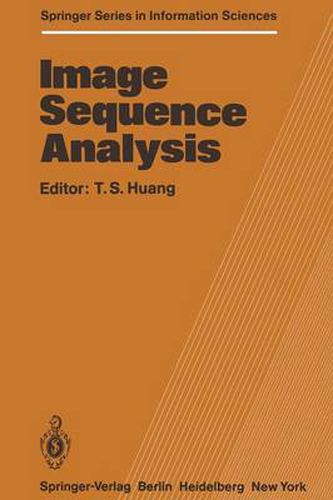Readings Newsletter
Become a Readings Member to make your shopping experience even easier.
Sign in or sign up for free!
You’re not far away from qualifying for FREE standard shipping within Australia
You’ve qualified for FREE standard shipping within Australia
The cart is loading…






This title is printed to order. This book may have been self-published. If so, we cannot guarantee the quality of the content. In the main most books will have gone through the editing process however some may not. We therefore suggest that you be aware of this before ordering this book. If in doubt check either the author or publisher’s details as we are unable to accept any returns unless they are faulty. Please contact us if you have any questions.
The processing of image sequences has a broad spectrum of important applica tions including target tracking, robot navigation, bandwidth compression of TV conferencing video signals, studying the motion of biological cells using microcinematography, cloud tracking, and highway traffic monitoring. Image sequence processing involves a large amount of data. However, because of the progress in computer, LSI, and VLSI technologies, we have now reached a stage when many useful processing tasks can be done in a reasonable amount of time. As a result, research and development activities in image sequence analysis have recently been growing at a rapid pace. An IEEE Computer Society Workshop on Computer Analysis of Time-Varying Imagery was held in Philadelphia, April 5-6, 1979. A related special issue of the IEEE Transactions on Pattern Anal ysis and Machine Intelligence was published in November 1980. The IEEE Com puter magazine has also published a special issue on the subject in 1981. The purpose of this book is to survey the field of image sequence analysis and to discuss in depth a number of important selected topics. The seven chap ters fall into two categories. Chapters 2, 3, and 7 are comprehensive surveys on, respectively, the whole field of image sequence analysis, efficient coding of image sequences, and the processing of medical image sequences. In Chapters 1, 4, 5, and 6 the authors present mainly results of their own research on, respectively, motion estimation, noise reduction in image sequences, moving object extraction, and occlusion.
$9.00 standard shipping within Australia
FREE standard shipping within Australia for orders over $100.00
Express & International shipping calculated at checkout
This title is printed to order. This book may have been self-published. If so, we cannot guarantee the quality of the content. In the main most books will have gone through the editing process however some may not. We therefore suggest that you be aware of this before ordering this book. If in doubt check either the author or publisher’s details as we are unable to accept any returns unless they are faulty. Please contact us if you have any questions.
The processing of image sequences has a broad spectrum of important applica tions including target tracking, robot navigation, bandwidth compression of TV conferencing video signals, studying the motion of biological cells using microcinematography, cloud tracking, and highway traffic monitoring. Image sequence processing involves a large amount of data. However, because of the progress in computer, LSI, and VLSI technologies, we have now reached a stage when many useful processing tasks can be done in a reasonable amount of time. As a result, research and development activities in image sequence analysis have recently been growing at a rapid pace. An IEEE Computer Society Workshop on Computer Analysis of Time-Varying Imagery was held in Philadelphia, April 5-6, 1979. A related special issue of the IEEE Transactions on Pattern Anal ysis and Machine Intelligence was published in November 1980. The IEEE Com puter magazine has also published a special issue on the subject in 1981. The purpose of this book is to survey the field of image sequence analysis and to discuss in depth a number of important selected topics. The seven chap ters fall into two categories. Chapters 2, 3, and 7 are comprehensive surveys on, respectively, the whole field of image sequence analysis, efficient coding of image sequences, and the processing of medical image sequences. In Chapters 1, 4, 5, and 6 the authors present mainly results of their own research on, respectively, motion estimation, noise reduction in image sequences, moving object extraction, and occlusion.